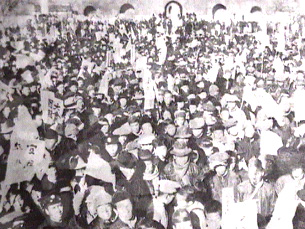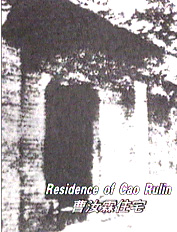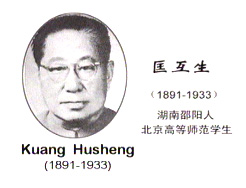 |
|
Adolescent China (6)
May 4 |
| CCTV.COM 2002-10-30 10:10:14 |
|
 May 4, 1919 was a Sunday. It was calm in the city of Beijing. In his diary, Lu Xun described the weather of that day like this: May 4, 1919 was a Sunday. It was calm in the city of Beijing. In his diary, Lu Xun described the weather of that day like this:
Sunny, cloudy in the afternoon, a drizzle after a gust of wind at night.
--Lu Xun’s diary
Nobody thought that a storm was imminent.
It was a day to be remembered by history. The details were covered by a report carried by “The Morning News” on the following day. The report could help us visualize the scenes of that day.
Around 1:30 p.m., more than 3,000 students gathered at Tian’anmen Square. They represented 13 universities and schools in Beijing. Leaflets carrying the “Declaration of the Educational Circles in Beijing” were distributed. Speakers on square tables lifted up their voices. Slogans rang out continuously. The students left a deep impression on the urban residents. Many people stood along the street, with tears streaming down their cheeks. They responded to the students’ shouts. Many foreigners cheered the students or waved their hats.
The procession marched in good order. Boy and girl scouts and schoolchildren joined the procession.
They turned to the east and reached the west end of Dongjiaominxiang Lane. They sent in petitions to the legations of the United States, Britain and other countries, expressing their firm determination to recover the rights and interests of Shandong Province.
Bingxin was attending a patient in a German hospital. Later she recalled that she had been shaken up to the literary arena of May 4th.
 The residence of Cao Rulin, a Chinese envoy attending the peace conference in Paris, was at Zhaojialou Lane. There the demonstrators were blocked by the police. They got angry. The residence of Cao Rulin, a Chinese envoy attending the peace conference in Paris, was at Zhaojialou Lane. There the demonstrators were blocked by the police. They got angry.
Kuang Husheng, a student of Beijing Senior Normal School, had learned martial arts since childhood. He was of firm character. He led the demonstrators to the residence of Cao Rulin on Zhaojialou Lane and set it on fire. The May 4th incident reached the climax.
 Zheng Zhenduo taking an afternoon nap at home was awakened by cries outside the windows. Later he recalled that the fire on Zhaojialou Lane changed his life. Zheng Zhenduo taking an afternoon nap at home was awakened by cries outside the windows. Later he recalled that the fire on Zhaojialou Lane changed his life.
Xu Shichang, President of the Republic, was enraged by the students’ action. He ordered arrests. The police and soldiers blocked Beijing University. The extremist action of the government escalated the incident.
On the following day, a poster carrying the poem “The River All Red” by Yue Fei was put up in Qinghua University. It was copied by Wen Yiduo, a student of the second year at the university. The patriotic students’ movement spread rapidly all over the country.
Xu Lingying was a girl student in the procession in Tianjin, and now she is 95 years old.
“We were surrounded by the police and soldiers. They blocked our way. It was overcast. The police and soldiers began to beat us. They drove me off. I was with a fellow student from Guangdong Province. Because we were short, we were at the head of the procession. I was with her. We were separated when they beat us. She got a beating. My head was beaten with a rifle butt,” said Xu Lingying.
The May 4th Movement changed the lives of many people like Xu Lingying. It was an age of heroes, an age of hopes and vitality. Like a brilliant spiritual sunrise, it illuminated China of the 20th century. This was adolescent China.
|
|
Editor: Liu Baoyin CCTV.com
|
|
|
|
|
|
 |









